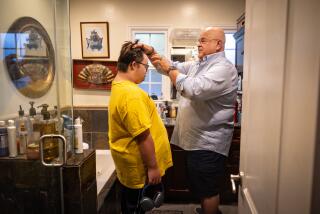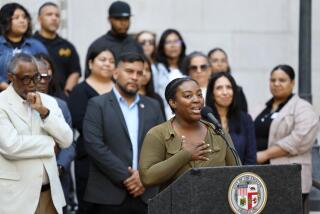UCLA study suggests Partners for Children benefits patients, state

- Share via
For two months Stephanie Aldana’s son complained of intense pain in his back and tremors in his legs. Doctors visits revealed nothing. She could do little but try to comfort 10-year-old Isaac as his feet swelled and his mobility deteriorated. Then Isaac lost sensation below his waist and an emergency MRI led to stark news: The fourth-grader had Ewing’s sarcoma, a rare cancer that can attack the bones.
Aldana and her husband were at a loss. How would they combat a grave illness within a vast medical system that had already proved frustrating and confusing?
But when a hospital case manager enrolled the La Habra family in Partners for Children, a state-administered program that offers low-income patients both treatment for disease and in-home hospice services, the family found a sense of relief.
“I would have been helpless, just not knowing the right person to speak to,” Aldana, 36, said. “Through the program you have people who can advocate for you and who care about you.”
The pilot program began working with patients in early 2010 and has been made available to more than 135 families covered by Medi-Cal in Los Angeles and 10 other counties. Participants were infants and youths up to 21 years old who had been diagnosed with life-threatening illnesses, including cystic fibrosis, cancer, and neuromuscular and cardiac disorders. Families were assigned a liaison in charge of coordinating the child’s care and given 24-hour access to a nurse familiar with the patient’s situation.
According to a study released Wednesday by the UCLA Center for Health Policy Research, children in the Partners program spent less time in the hospital, their families’ quality of life improved and their medical costs fell by 11%.
They found that on average, $1,677 was saved per child per month.
The findings were not surprising, said researcher Daphna Gans, who believes the program demonstrates a more efficient and effective way to care for ill children.
“The idea is, you minimize visits to the ER and also catch things early,” said Gans.
Participating families reported increased confidence in caring for their children and a decrease in stress and worry, and 97% of participants said they would recommend the program to others.
Normally, Medicaid families are eligible for both treatment and hospice care only when a child has six months or less to live. Partners for Children operates under a federal waiver that allows it to circumvent that requirement.
The study results suggest that such a change to the usual Medicaid approach would not only avoid forcing heartbreaking choices on parents but also save the state money, said Devon Dabbs of the Children’s Hospice and Palliative Care Coalition, which initiated the study.
“There is no life expectancy attached to this program, and it ensures they can stay at home, which is where most kids want to be,” Dabbs said. “There’s been a lot of anecdotal research and estimated savings, but this is the first time we can look at strong data and say here’s what it costs us and here’s what it’s saving us.”
The program ends later this year and will probably be renewed as a five-year program that could be expanded into 14 additional counties. Although a change to state policy is not likely soon, Dabbs said it is not unusual for programs to operate under a federal waiver for decades.
Terri Warren, chief executive of participating Providence TrinityCare Hospice, a nonprofit based in Torrance, said: “It’s something that just intuitively on a human level should have been in place years ago because it makes sense.”







